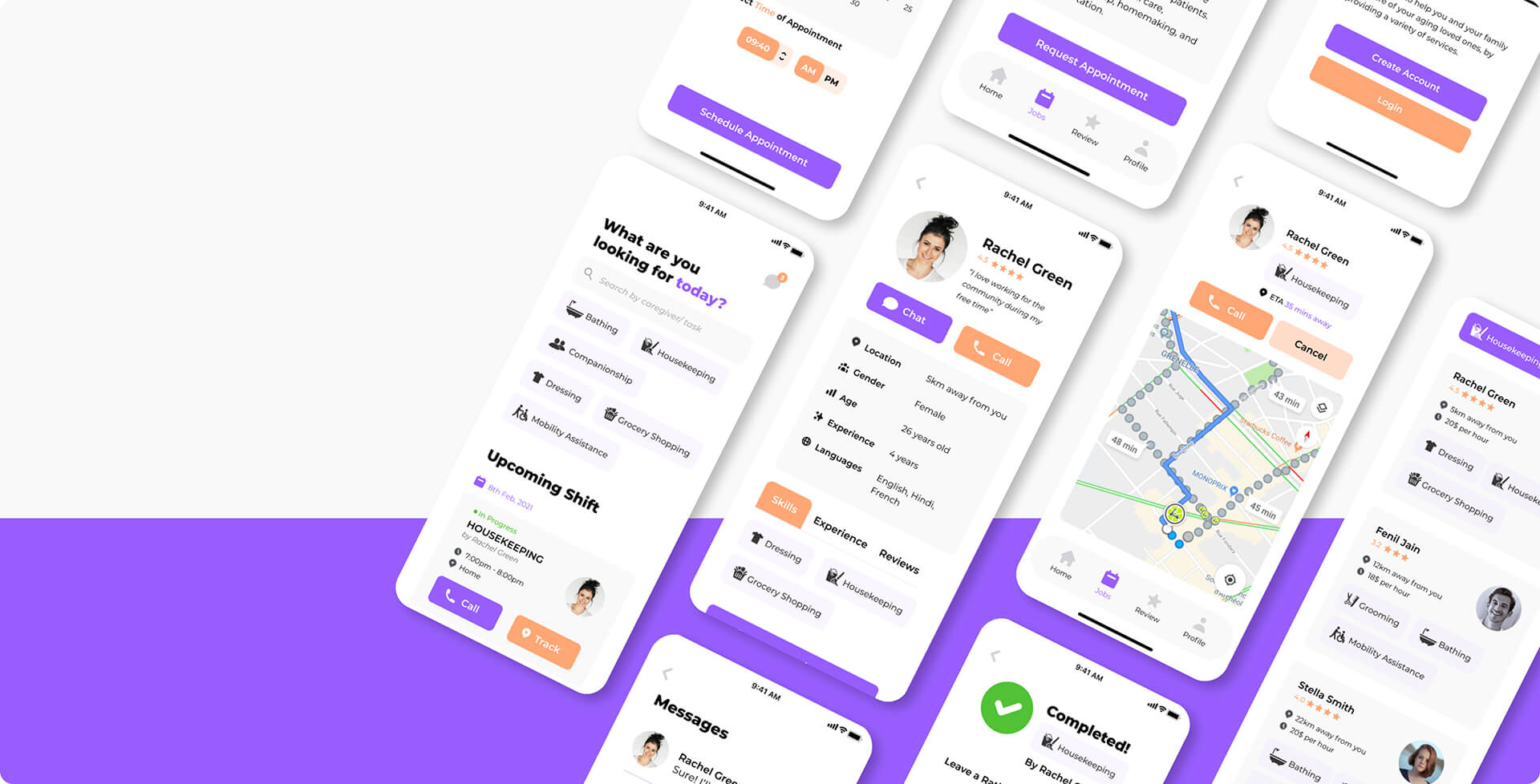
Uplift: Simplifying Care for Your Loved Ones
A digital platform designed to support busy professionals in managing caregiving responsibilities for the elderly
About
Problem
Outcome
Role
Duration
Tools
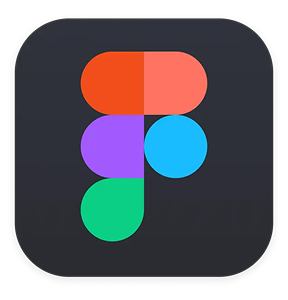


Uplift simplifies caregiving by enabling users to quickly explore caregiver profiles, schedule appointments, track their status, and leave reviews
Target Users
Main Features
- Caregiver Search & Profiles
- Appointment Requests &
- Scheduling
- Tracking & Communication
- Caregiver Reviews
Fun Fact!
Why this project mattered to me?
Watching my dad juggle the demands of work, family, and caring for my granddad, who resisted external help—showed me the challenges of caregiving firsthand
This project mattered to me because I wanted to create a solution that could lighten that burden and build trust in caregiving support, especially for my dad.
It’s tough, you know? Managing everything with work, you guys, and making sure he’s okay—it feels like there’s never enough time in the day.
~ My dad
I don’t need help from outside! I don’t feel comfortable with strangers in my home. I trust your dad.
~ My grandad
Part 1 of 6:
Discovering User Needs
What I Found While Researching
What’s the current problem faced by caregivers like my dad?
Caregivers like my dad need to balance work, family, and elderly care, often without sufficient support, leading to physical and emotional burnout
This challenge is heightened when trust in external caregiving services is lacking.

I need to get everything in place before the day starts. I just hope I can manage both my work and taking care of him.
~ My dad’s morning thoughts

I need to get everything in place before the day starts. I just hope I can manage both my work and taking care of him.
~ My dad’s morning thoughts

I feel like I’m giving only half of myself to everything. I hope I can catch up on work tonight.
~ My dad’s afternoon thoughts

I just hope tomorrow’s a bit easier, but I can’t be so sure! Maybe I’ll ask my daughter to help out too.
~ My dad’s evening thoughts
How did we refine the problem scope?
Conducted a competitive analysis of existing caregiver apps, to help identify gaps and opportunities
Analyzed apps like Medisafe, Evercare Caregiver, Oscer Senior, Rosemary Caregiver below:
MEDISAFE
EVERCARE CAREGIVER
OSCER SENIOR
ROSEMARY CAREGIVER




Competitor Type
Indirect
Direct
Indirect
Direct
Target Audience
Medisafe is intended for patients who are on multiple medications for chronic diseases and who have a hard time complying with their prescription medications.
The Evercare Caregiver Apps primary target was the Hispanic senior market, aged 65+ with Medicare, with low income and/or chronically ill condition
Oscar Senior’s primary target was senior citizens in the world and their loved ones. They also targetted the market for probable caregivers.
Rosemark Caregiver mobile application targetted mainly the adult age group and senior citizens in the need for caregivers.
MEDISAFE
EVERCARE CAREGIVER
OSCER SENIOR
ROSEMARY CAREGIVER




Competitor Type
Indirect
Direct
Indirect
Direct
Target Audience
Medisafe is intended for patients who are on multiple medications for chronic diseases and who have a hard time complying with their prescription medications.
The Evercare Caregiver Apps primary target was the Hispanic senior market, aged 65+ with Medicare, with low income and/or chronically ill condition
Oscar Senior’s primary target was senior citizens in the world and their loved ones. They also targetted the market for probable caregivers.
Rosemark Caregiver mobile application targetted mainly the adult age group and senior citizens in the need for caregivers.
MEDISAFE
EVERCARE CAREGIVER
OSCER SENIOR
ROSEMARY CAREGIVER




Competitor Type
Indirect
Direct
Indirect
Direct
Target Audience
Medisafe is intended for patients who are on multiple medications for chronic diseases and who have a hard time complying with their prescription medications.
The Evercare Caregiver Apps primary target was the Hispanic senior market, aged 65+ with Medicare, with low income and/or chronically ill condition
Oscar Senior’s primary target was senior citizens in the world and their loved ones. They also targetted the market for probable caregivers.
Rosemark Caregiver mobile application targetted mainly the adult age group and senior citizens in the need for caregivers.
MEDISAFE
EVERCARE CAREGIVER
OSCER SENIOR
ROSEMARY CAREGIVER




Competitor Type
Indirect
Direct
Indirect
Direct
Target Audience
Medisafe is intended for patients who are on multiple medications for chronic diseases and who have a hard time complying with their prescription medications.
The Evercare Caregiver Apps primary target was the Hispanic senior market, aged 65+ with Medicare, with low income and/or chronically ill condition
Oscar Senior’s primary target was senior citizens in the world and their loved ones. They also targetted the market for probable caregivers.
Rosemark Caregiver mobile application targetted mainly the adult age group and senior citizens in the need for caregivers.
MEDISAFE
EVERCARE CAREGIVER
OSCER SENIOR
ROSEMARY CAREGIVER




Competitor Type
Indirect
Direct
Indirect
Direct
Target Audience
Medisafe is intended for patients who are on multiple medications for chronic diseases and who have a hard time complying with their prescription medications.
The Evercare Caregiver Apps primary target was the Hispanic senior market, aged 65+ with Medicare, with low income and/or chronically ill condition
Oscar Senior’s primary target was senior citizens in the world and their loved ones. They also targetted the market for probable caregivers.
Rosemark Caregiver mobile application targetted mainly the adult age group and senior citizens in the need for caregivers.
Setting the Stage
How might we alleviates the emotional & logistical challenges of elderly caregiving for busy professionals, making it easy to find, manage, and receive support from trusted caregivers?
Part 2 of 6:
Defining the Vision
How I Connected the Dots
Who are the users of this app?
Individuals like my dad and granddad, i.e. caregivers and family members navigating the challenges of managing elderly care, while balancing other responsibilities
Below are the user personas I created to better understand the needs and challenges faced by caregivers and family members managing elderly care.
User Persona 1: Dad (Caregiver)
"I want to do my best for my dad, but juggling everything feels impossible sometimes."
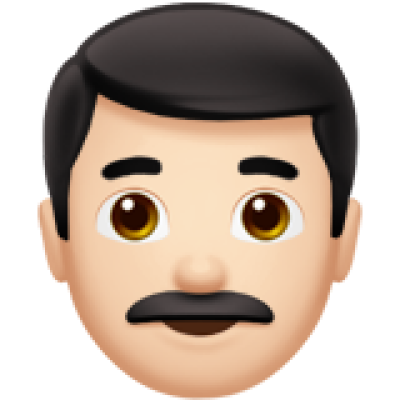
Location: India
Family: Married, with two kids
Occupation: Partner at a company
User Needs & Goals:
Needs the ability to compare and find the best caregiver in the area, an easy-to-use interface, personalized caregiving options, and notifications after caregiver tasks/shift completion.
Behaviors and Motivations:
Prioritizes family & work balance but feels overwhelmed and is motivated by finding a reliable caregiver for his dad, preferring transparency in the process.
Pain Points:
Struggles with caregivers canceling at the last moment, insufficient information to select caregivers, no live tracking of caregiver schedules and availability, and false reviews and ratings.
Preferred Features:
Prefers a simple, intuitive interface with clear, up-to-date caregiver availability and trustworthy reviews and verified ratings.
User Persona 1: Granddad (Care Recipient)
"I miss my wife and my kids are too busy to visit. Sometimes I feel alone and helpless!"
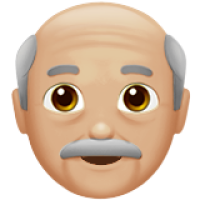
Location: India
Family: Married, with grandkids
Occupation: Retired Navy Officer
User Needs & Goals:
Needs an easy and simple interface, the ability to receive virtual consultations for medicines, and a simple, quick process to book a caregiver for everyday chores/tasks.
Behaviors and Motivations:
Spends most of his day watching TV and relies on his son/ neighbors for help. Motivated by finding reliable support for his everyday needs & regaining a sense of independence.
Pain Points:
Struggles with a lack of multiple language support, is confused by too many options, lacks trust with new caregivers, and becomes easily irritated when tasks aren’t done as directed.
Preferred Features:
Prefers a simple, user-friendly interface with language options, clear caregiver profiles, and the ability to schedule tasks easily.
How did we explore our users’ daily experiences with caregiving?
Created a journey map to visualize the emotional, cognitive, and logistical challenges my dad faces based on the quotes he shared during the interview
From journey mapping, I learned that my dad struggles with:
Journey Map 1: A day in the life of my dad as a caregiver & professional
This journey map highlights the emotional, cognitive, and behavioral challenges my dad faces balancing elderly caregiving and work, from stress and guilt to relief and pride.
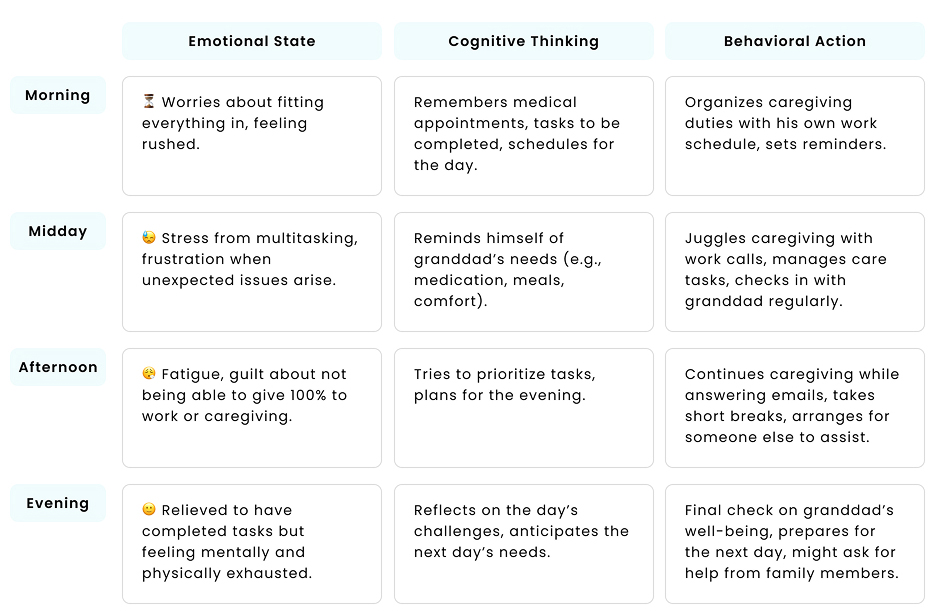
Part 3 of 6:
Shaping the Experience
Turning Insights into Concepts
How did we analyze this data into actionable insights?
Identified critical pain points in caregiving platforms to uncover patterns and key themes that guided our design decisions and initial wireframing efforts
Through a thorough analysis, we observed the following key takeaways:
Key Takeaway 1:

Limited caregiver reviews and insufficient data
Users struggle to assess caregivers due to a lack of ratings and comprehensive information.
Key Takeaway 2:
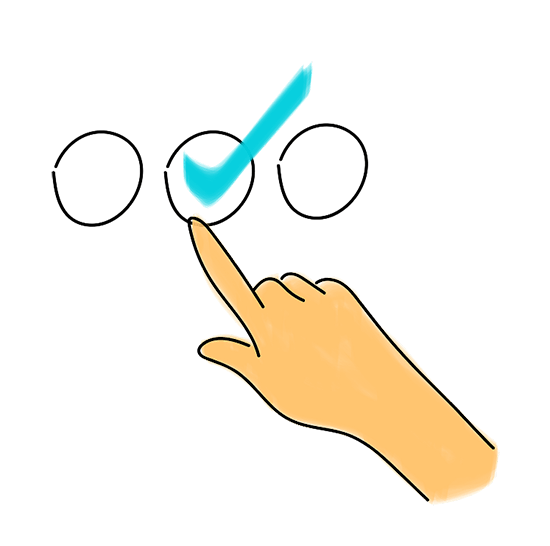
Lack of task/shift completion alerts
Absence of notifications leaves users unaware of caregiver task statuses, creating communication gaps.
Key Takeaway 1:

Language barriers in communication
Miscommunication arises due to language differences, affecting the quality of care.
How did we turn these takeaways into practical solutions?
Developed an overall user flow based on identified themes to guide the creation of our low-fidelity wireframes
We created the following user flow:
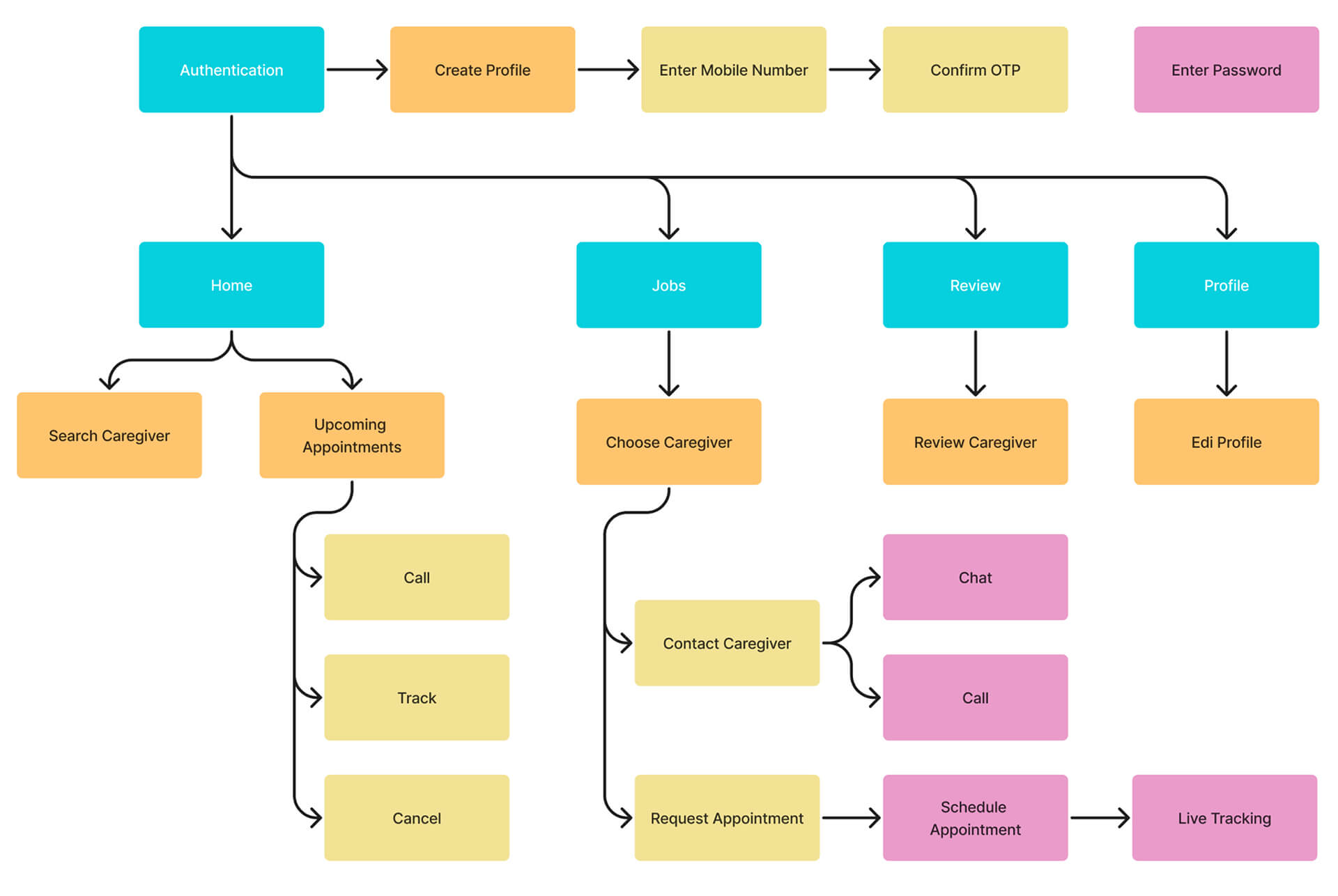
What assumptions did we make while designing the app?
The key assumptions made regarding user information, caregiver verification, and accessibility features, guided the app's design process
We created the following user flow:
Assumption 1:
User Information and Default Language
Assumes user or patient data is pre-loaded, with English as the primary language.
Assumption 2:
Verified and Reviewed Caregiver Profiles
Assumes that all caregivers are verified and their profiles undergo a review process for quality assurance.
Assumption 3:
Voice Assistance and Multi-Language Support
Assumes the app supports multiple languages & voice assistance for inclusive communication.
Part 4 of 6:
Making It Real
Where Ideas Become Visuals
What visual aesthetic did I envision for the app?
I aimed for a clean and accessible design that caters to senior citizens while maintaining modern appeal
Purple was chosen as the primary color to ensure visual clarity and to represent both warmth and calmness, complemented by orange for vibrancy and accessibility.
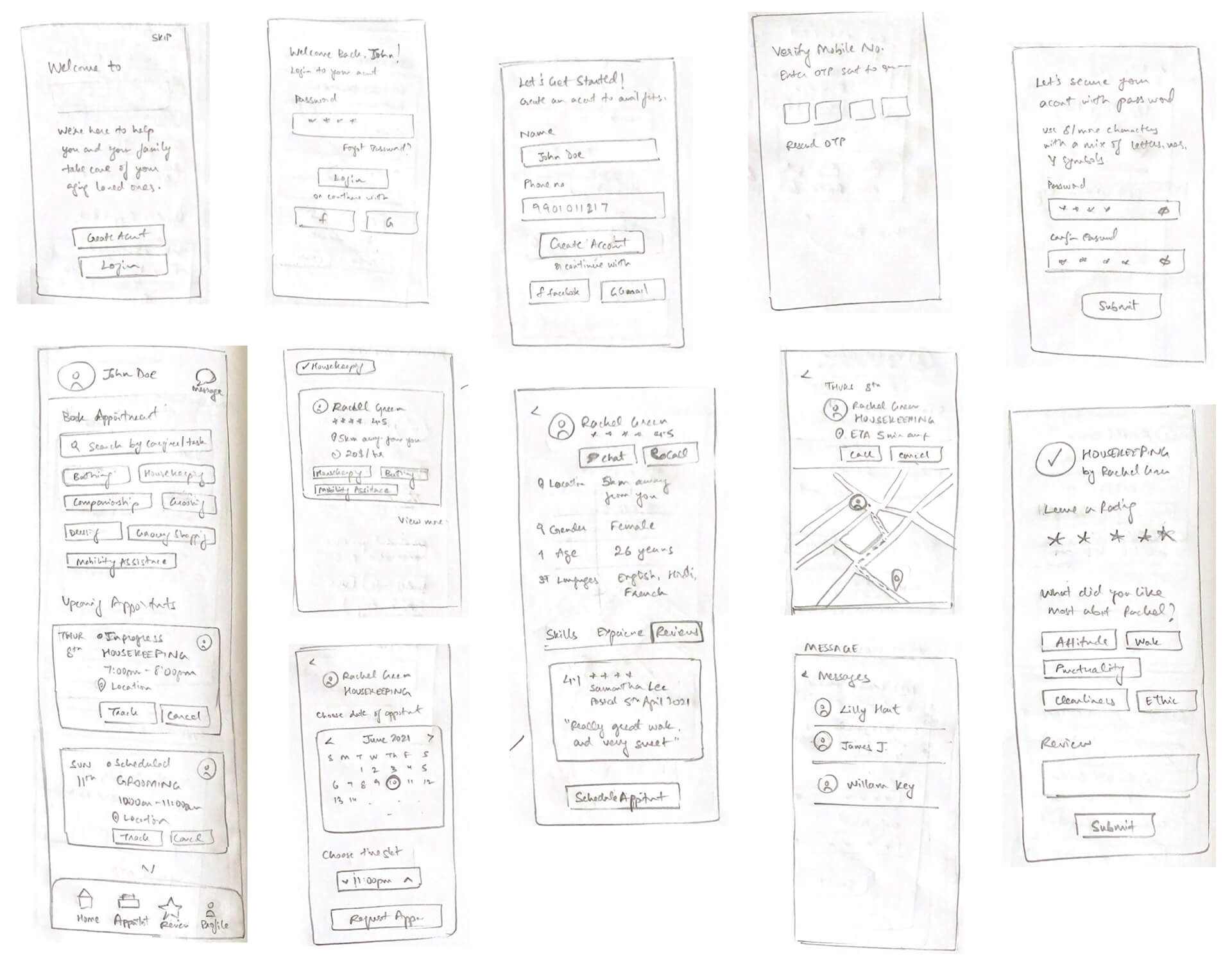
What font style best suits this application?
I focused on selecting typography that was both clear and modern, to ensure readability for older users
The font family chosen is clear and easy to read. Additionally, the color purple, as the meeting point between warm red and cool blue on the color wheel, offers a balance between comfort and energy. This avoids cool colors like blue and green, which can be harder to distinguish for older users, creating an inviting and easy-to-navigate interface.
This avoids cool colors like blue and green, which can be harder to distinguish for older users, creating an inviting and easy-to-navigate interface.
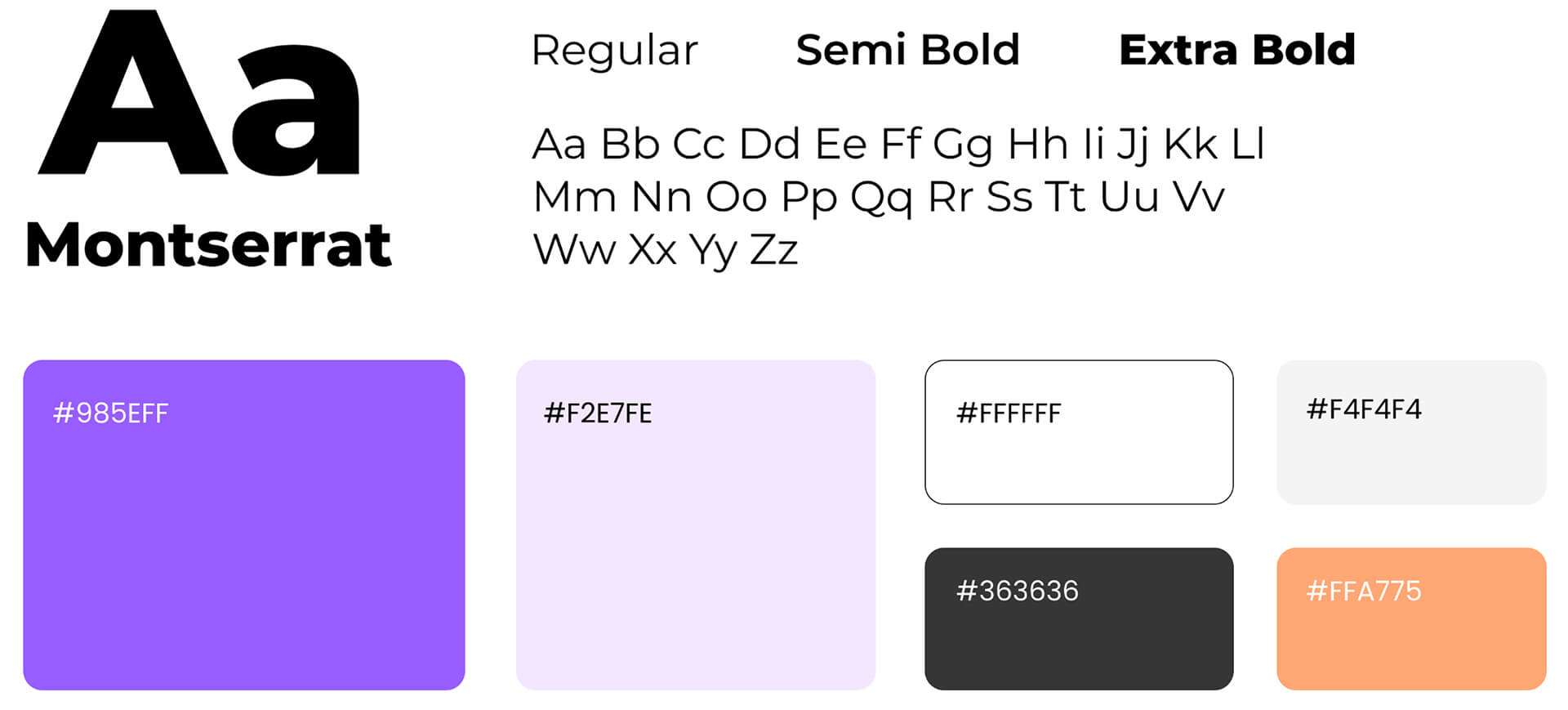
Did we achieve what we set out to do with this project?
Yes, we achieved our goal with Uplift by designing a platform that supports individuals in managing caregiving responsibilities
Uplift simplifies the caregiving experience by allowing users to easily explore caregiver profiles, schedule appointments, track status, and leave reviews.
Authentication Screens
Effortless account setup and login for users
- New account setup
- Returning user login
- Secure access
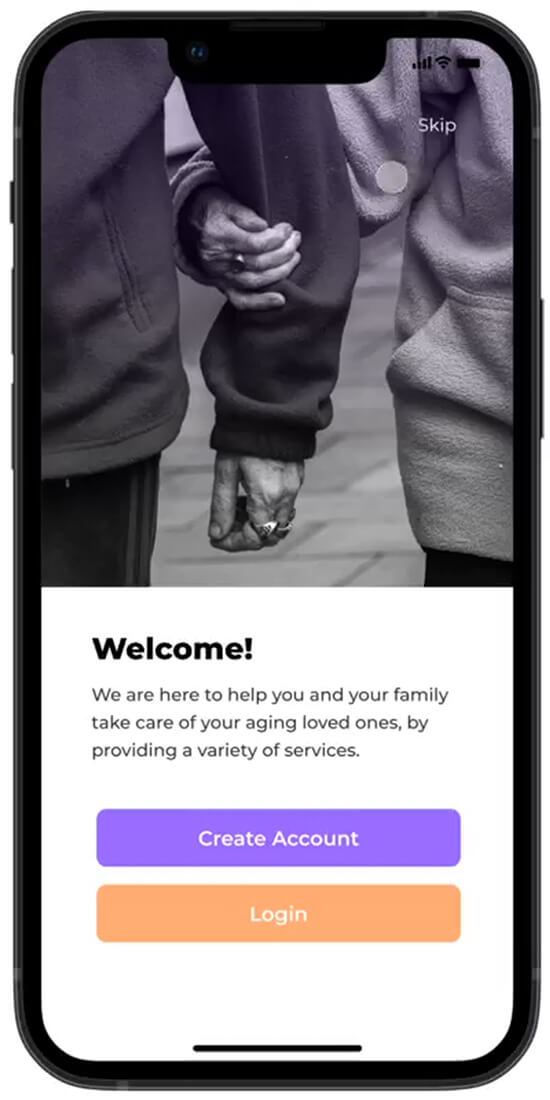
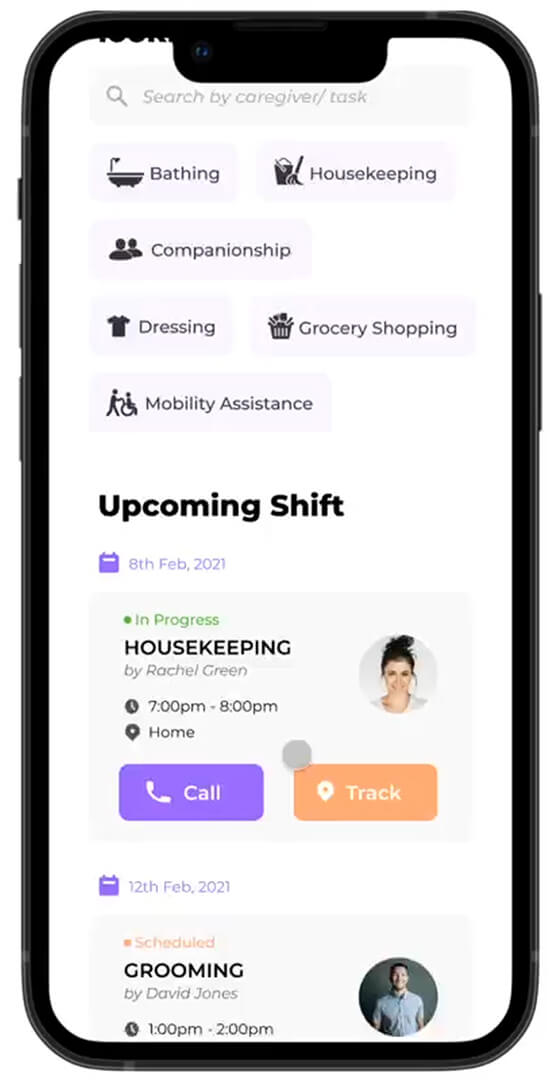
Home Screen
Centralized hub for caregiver services and communication
- Select services
- Message, track, call caregivers
- Notifications for updates
Appointment Screens
View caregiver profiles and request a service via appointments
- View skills, experience, reviews
- Request appointments easily
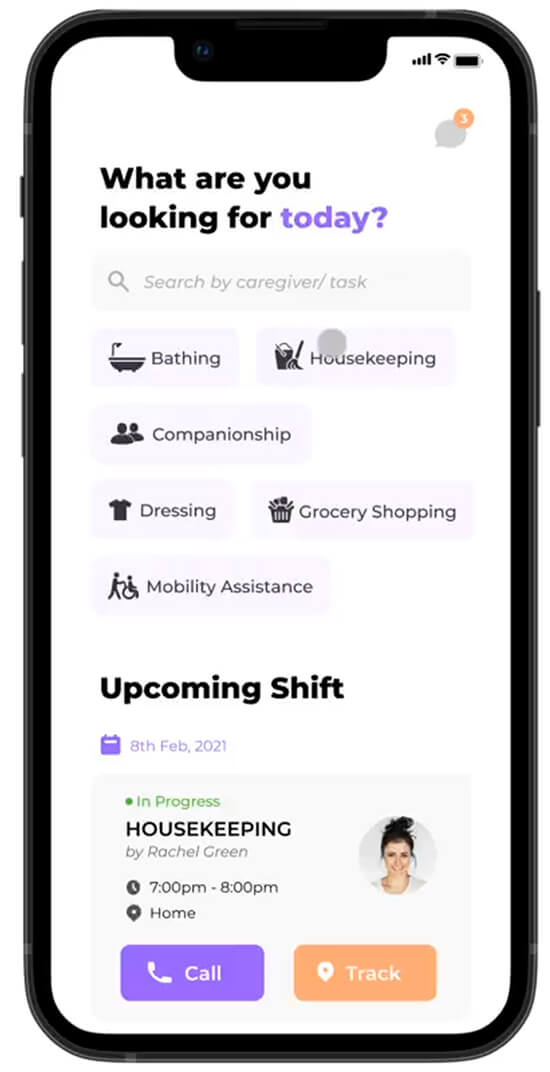
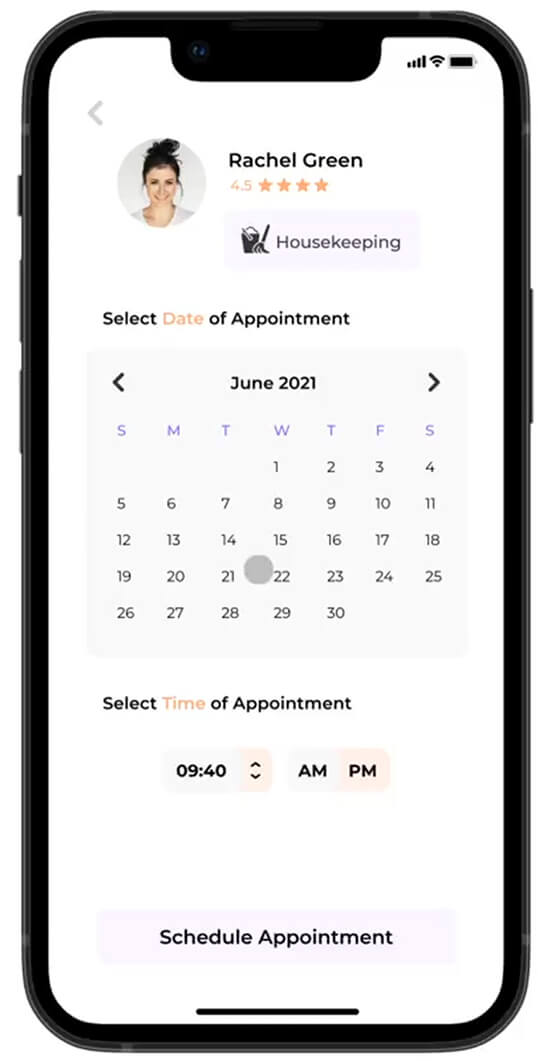
Tracker & Review Screens
Simple scheduling, tracking, and post-appointment reviews
- Choose time/date for appointment
- Track status
- Post reviews

Part 6 of 6:
Reflections and Future Visions
What I Learned and What’s Next
What are my next steps for improving this app?
To build a caregiver-side app, integrate recurring appointments, expand testing, enhance personalization, and actively incorporate user feedback
- Allow caregivers to manage appointments, accept/decline requests, and update availability.
- Enable users to schedule repeat appointments seamlessly.
- Conduct trials with a broader and more diverse user base to refine features and interface.
- Add customization options to improve usability for different user needs.
Key Takeaways
Simplified caregiver search through intuitive design, shaped by personal understanding of caregiving challenges and time-bound research.
Impact:
Inspired by my dad’s caregiving journey, this app simplifies finding and managing caregivers, fostering ease and reliability for families.
Next Steps:
Enable caregiver-side management, seamless recurring appointments, diverse user testing, and enhanced customization for improved usability.
Ruchica, I’m so proud of what you’ve created! This is something I wish had existed when I needed it most. You’ve really thought about the challenges caregivers and families face, and its amazing to see how much care and attention you’ve put into making life easier for me and others.
~ My dad shared during the final interview session
Check out more projects!

UMD Course Project
FocusBuddy: Turn Chaos into Clarity
A participatory co-design research with graduate students diagnosed with ADHD, to develop an adaptive task management app

UMD Course Project
BeepTest: Simplifying Performance Tracking
A visual redesign of the beep test application flow that helps coaches & trainers enter results for a beep test in a simple and quick way.

UMD Course Project
GetFit: Track. Achieve. Repeat.
Co-designing a fitness app with ChatGPT to make logging workouts and tracking progress simple, quick, and engaging for users.
Scroll to top !